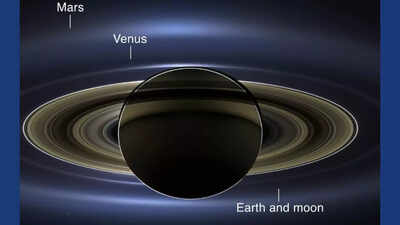Trending
This story is from September 4, 2023
Watch: NASA's Cassini captures stunning images of Saturn, Earth, and Moon as tiny dots
NASA's Cassini spacecraft has captured an image of Saturn, Earth, and the Moon, with the planets appearing as tiny dots. The image, taken from a distance of approximately 746,000 miles, shows Venus as a white dot, Mars as a faint red dot, Earth as a pale blue dot, and the Moon as a smaller dot

(Source: @NASA/Instagram)
In this image, planets appear as minuscule dots as NASA's Cassini spacecraft delivers breathtaking snapshots of Saturn, Earth, and the Moon.
The picture portrays Mars, Earth, and the Moon as tiny dots suspended in space. These celestial bodies are depicted as mere specks in the image, which was created by employing blue, green, and red filters to render the scene in its natural colours.
NASA consistently captivates the attention of the online community through its daily missions and the extraordinary images it shares from the depths of interstellar space.NASA's Instagram page brims with captivating images and fascinating facts about the universe, perpetually intriguing those who ponder the mysteries of our existence.
Ever wondered how our home planet might appear from millions of miles away, and how it compares to other celestial bodies in our solar system? This image, captured by the Cassini spacecraft from a distance of approximately 746,000 miles (or 1.2 million kilometres), provides a unique perspective. It was taken using red, green, and blue filters, resulting in a natural-colour view of Venus, Mars, and Earth, all of which manifest as diminutive points of light.
Here's a closer look at the elements within the image:
Venus appears as a brilliant white dot in the upper left corner. Mars is positioned diagonally above Venus, appearing as a faint red dot. Earth and the Moon are depicted in the second image, with Earth as a pale blue dot and the Moon as a smaller dot in the lower right corner.
Cassini was not the first spacecraft to explore Saturn up close; Pioneer 11, a spacecraft that paved the way for solar system exploration, first studied Saturn 44 years ago. Since its posting, this image has garnered more than a million likes and several thousand comments. One user even humorously commented, "The original lord of the Rings!" while another simply stated, "Space is beautiful." Cassini also shared another captivating image in July of this year, featuring the moon Mimas on Instagram. This image showcased the moon and Saturn's expansive rings, providing a wide-angle view of the gas giant's atmosphere.
The picture portrays Mars, Earth, and the Moon as tiny dots suspended in space. These celestial bodies are depicted as mere specks in the image, which was created by employing blue, green, and red filters to render the scene in its natural colours.
NASA consistently captivates the attention of the online community through its daily missions and the extraordinary images it shares from the depths of interstellar space.NASA's Instagram page brims with captivating images and fascinating facts about the universe, perpetually intriguing those who ponder the mysteries of our existence.
Ever wondered how our home planet might appear from millions of miles away, and how it compares to other celestial bodies in our solar system? This image, captured by the Cassini spacecraft from a distance of approximately 746,000 miles (or 1.2 million kilometres), provides a unique perspective. It was taken using red, green, and blue filters, resulting in a natural-colour view of Venus, Mars, and Earth, all of which manifest as diminutive points of light.
Sharing this captivating image on its Instagram profile, NASA stated, "Cassini not only captured the gas giant but also some unexpected photobombers: Venus, Mars, Earth, and Earth's Moon, all visible as tiny points of light. Saturn, the sixth planet from the Sun, will grace our skies daily at sunset until February 2024, resembling a bright yellowish 'star' on the southeastern horizon."
Here's a closer look at the elements within the image:
Venus appears as a brilliant white dot in the upper left corner. Mars is positioned diagonally above Venus, appearing as a faint red dot. Earth and the Moon are depicted in the second image, with Earth as a pale blue dot and the Moon as a smaller dot in the lower right corner.
Cassini was not the first spacecraft to explore Saturn up close; Pioneer 11, a spacecraft that paved the way for solar system exploration, first studied Saturn 44 years ago. Since its posting, this image has garnered more than a million likes and several thousand comments. One user even humorously commented, "The original lord of the Rings!" while another simply stated, "Space is beautiful." Cassini also shared another captivating image in July of this year, featuring the moon Mimas on Instagram. This image showcased the moon and Saturn's expansive rings, providing a wide-angle view of the gas giant's atmosphere.
End of Article
FOLLOW US ON SOCIAL MEDIA









